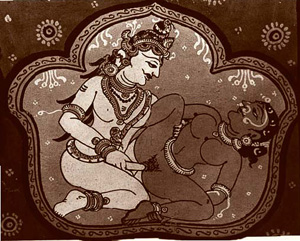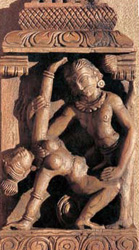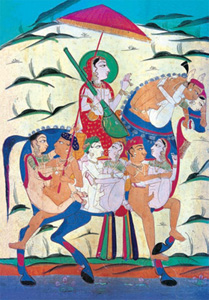Sexual union

Ratavasthapana Prakarana

 an is divided into three classes:
shasha, the hare; vrisha, the bull; and ashwa, the horse, according to the size of his
lingam, or phallus.
an is divided into three classes:
shasha, the hare; vrisha, the bull; and ashwa, the horse, according to the size of his
lingam, or phallus.
A woman too, according to the depth of her yoni, vagina, is either a mrigi, female deer; vadava, a mare; or a hastini, female elephant.
Equal and Unequal Unions of Dimensions
There are three equal unions between persons of corresponding dimensions and six unequal unions when the dimensions do not correspond, or nine kinds of unions in all.
| Equal | ||
| Male | Female | |
| phallus | vagina | |
| Hare | Deer | |
| Bull | Mare | |
| Horse | Elephant |
| Unequal | ||
| Male | Female | |
| phallus | vagina | |
| Hare | Mare | |
| Hare | Elephant | |
| Bull | Deer | |
| Bull | Elephant | |
| Horse | Deer | |
| Horse | Mare |

In unequal unions, when the male exceeds the female in point of size, his union with a woman immediately next to him in size is called high union and is of two kinds; while his union with a woman most remote from his size is called the higher union and is of one kind only. When the female exceeds the male in point of size, her union with a man immediately next to her in size is called low union and is of two kinds; while her union with a man farthest from her in size is called the lower union and is of one kind only.
In other words, the horse and the mare, and the bull and the deer form the high union; while the horse and the deer form the highest union. On the female side, the elephant and the bull, and the mare and the hare, form low unions; while the elephant and the hare form the lowest unions.
There are, then, nine kinds of union according to dimensions. Equal unions are the best; the highest and the lowest are the worst. The rest are middling, and among them high unions are considered better than the low, for in a high union, the male can satisfy his own passion without hurting the female; in a low union, it is difficult for a female to be satisfied in any manner.

This Orissa pata shows Shiva in congress with his consort, Parvati. He holds his lingam in his hand and turns it around in her yoni in an action described as churning. She places her thighs, with her legs doubled on them, on her sides and engages in congress in the position of Indrani.

Unions of Passion
There are also nine kinds of union according to the force of passion or carnal desire:
A man of small passion is one whose desire at the time of sexual union is not great, whose semen is scanty, and who cannot bear the warm embraces of the female.
Men of intense passion are full of desire. Yet others who are neither passionate nor indifferent, are those of middling passion.
Similarly, women are supposed to fall into the same three degrees of feeling: small, middling and intense.
Unions of Time
Lastly, based on time, there are three kinds of men and women: the short-timed, the moderate-timed, and the long-timed, and as with the others, there are nine kinds of union.
But in this last category there is a difference of opinion about the female. Auddalika says, "Females do not emit as males do. Males simply remove their desire, while females, from their very consciousness of desire, feel a certain kind of pleasure which gives them satisfaction, but find it impossible to explain what kind of pleasure they feel. This becomes evident because males, when engaged in coition, cease of themselves after emission and are satisfied, but it is not so with females."
However, this opinion is debatable because if a male is long-timed, the female loves him more, but if he is short-timed, she is dissatisfied with him. And this, some say, proves that the female emits too.
On the contrary, if it takes a long time to allay a woman's desire, and during this time she enjoys great pleasure, it is quite natural that she should wish for its continuation. And on this subject there is a shloka:
By union with men the lust, desire or passion of women is satisfied, and the pleasure derived from the consciousness of it is called their satisfaction.

The woman's increased desire is evident as she climbs on to his lover's lap and embraces him.

The nayika prepares herself in the rising position as she raises both her thighs straight up. The congress takes place in a serene surrounding on the rooftop on a moonlit night. The hero removes his lingam to some distance from the yoni and then forcibly strikes it, described as giving a blow.
But according to the followers of Babhravya, the semen of women continues to fall from the beginning of the sexual union to its end, and it is right that it should be so, for if they had no semen, there would be no embryo.

There is, however, an opposing view too. At the beginning of coition the passion of the woman is middling and she cannot bear the vigorous thrusts of her lover, but by degrees her passion increases until she ceases to think about her body, and then finally, she wishes to stop further coition.
On this too there is a shloka:
The emission of semen, which marks the end of the sexual union, provides the man with the release of his long-sought pleasure; a woman, however, enjoys the union throughout. When they have both shed the semen, then they wish for the discontinuance of sexual intercourse.
Vatsyayana is of the opinion that the semen of the female falls in the same way as that of the male.
Relative Consciousness of Pleasure
Some people wonder why men and women have different reactions when they are beings of the same kind and engaged in bringing about the same results. Vatsyayana believes that this is because their consciousness of pleasure is different. Men are the actors, and women are the persons acted upon, in keeping with their individual natures; otherwise, the actor would sometimes be the person acted upon, and vice versa.

The acrobatic stretch of the woman's body allows for a beautiful visual and allows vigorous thrusts and deeper penetration to her lover.
And from this difference in reactions follows the difference in their consciousness of pleasure, for a man thinks, "This woman is united with me", and a woman thinks, "I am united with this man".
It may further be questioned that if the ways of working in men and women are different, why should there not be a difference even in the pleasure they feel?
Men and women, being of the
same nature, feel the same kind
of pleasure, and therefore a man
must first sexually arouse the
woman by ardent love play, and
then vigorously commence his sex
act, so that she reaches the
climax earlier or simultaneously
with him.
But this is not true: even though the person acting and the person being acted upon are of different kinds, and there is a difference in their ways of working, there is no reason for any difference in the pleasure they feel, because they both naturally derive pleasure from the act they perform.
There is a shloka on this subject:
Men and women, being of the same nature, feel the same kind of pleasure, and therefore a man must first sexually arouse the woman by ardent love play, and then vigorously commence his sex act, so that she reaches the climax earlier or simultaneously with him.
Since there are nine kinds of union with regard to dimensions, force of passion, and duration, their permutations and combinations would produce innumerable kinds of union. Therefore in each particular kind of sexual union, men should use such means as they think suitable for the occasion.
When experiencing sexual union for the first time, the passion of the male is intense and his time is short, but in subsequent unions on the same night, it becomes the reverse. With the female it is the contrary, for during the first time her passion is weak and her time long, but on subsequent occasions on the same night, her passion is intense and her time short.

The Rajasthani artist lets his imagination fly in this marvelous piece of art where four loving couples are engaged in passionate love play with their bodies rocking to the motion of a speeding horse.
It is a common belief that the man's emission occurs earlier than that of the woman's orgasm.
The following shloka states:
According to some ancient sages women with delicate limbs are by nature prone to achieving the climax earlier, as also stout women already excited by kissing, embracing and other outward caressing.
Four Kinds of Love
Men learned in the humanities are of the opinion that love is of four kinds:
Love resulting from the continual performance of an act is called love acquired by constant practice and habit, such as the love of sexual intercourse, hunting, drinking or gambling.
Love which results from ideas to which we are not habituated is called love due to imagination, such as that felt by some men, women, and eunuchs for the auparishtaka, or mouth congress; and that which is felt by all when embraced, kissed, stroked and scratched.

Lovers derive pleasure from the contact of minds along with their bodies. Vatsyayana says sexual games should be played and wagers should be laid to make ground for quarrels, which enhance and intensify passion.
Love which is mutual and proven to be true, when each looks upon the other as his or her very own, is called love resulting from belief. Love resulting from the perception of external objects is quite evident and well known to the world, because the pleasure which it affords is superior to the pleasure of other kinds of love, which exists only for its sake.
The foreplay, kissing, embracing and striking which arouse the passions of both the man and the woman to a point where sexual union is a natural culmination, evokes:
* Physical and mental exaltion
* Pleasure from the contact of minds generating love through physical union
* Love which fills the soul and overflows during physical union
* The combination of sexual pleasure and mutual love
* Ecstasy of physical union when the body and spirit conjoin
* Secluded love, enjoyment and peaceful rest
* Lifting of the mind above the mundane

The two lovers walking together in a lonely place, rub their bodies against each other. On this occasion one can also adopt the pressing embrace by pressing the others body forcefully against a support.